#Indian stock market history
Text
A Resounding Victory: The Indian Financial Market's Response to the 2019 Lok Sabha Election Results
The 2019 Lok Sabha elections in India were a significant event, not only politically but also economically. The landslide victory of the Bharatiya Janata Party (BJP) under the leadership of Narendra Modi sent ripples across various sectors, notably the financial markets.
This blog post delves into the intricate dynamics of how the Indian financial markets responded to the BJP’s victory and what…

View On WordPress
#2014#2019#2024#BankingSector#BJPGovernment#Economic reforms India#EconomicReforms#Election results market reaction#ElectionImpact#FinancialMarkets#Foreign direct investment India#ForeignInvestment#GST#GST Bill India#Indian financial markets#Indian stock market history#IndianEconomy#Infrastructure stocks India#InfrastructureStocks#Investor sentiment 2014#InvestorSentiment#Jan Dhan Yojana#JanDhanYojana#LokSabhaElections2014#Make in India#MakeInIndia#Market reaction to elections#MarketVolatility#Modi economic policies#Modi government policies
0 notes
Text
cf & dd timeline
This will not reflect every single aspect of the gilded age (1870s to 1890s) but it will include various points of historical and technological interest in addition to Nell and Steve’s personal histories. As such, spoilers will be included and updated with each chapter; so if you’d rather not deal with that, please avoid this!
Note: Italics denote events of the plot, & updates will occur after chapters are published. This is work in progress so more dates and details will be added as I think of them. Historical dates and information was provided by the National Humanities Center and my own research.
1858 - June: Samuel and Ameila Harrington welcome the birth of their son and heir, Steven.
November: Arthur and Delphine Fairchild welcome the birth of their daughter, Eleanor. (Occurs before the story starts, not depicted.)
1865 - Lincoln Inauguration, Civil War Ends, Lincoln Assassination, Ratification of the 13th Amendment
1866 - the National Labor Union was founded on August 20, First successful transatlantic cable is completed (England to the United States).
1868 - June 25: Congress enacts an 8-hour workday for workers employed by the government, July: Ratification of the 14th Amendment.
1869 - January: Grant Inauguration, Commanche Chief Toch-a-way informs Gen. Philip H. Sheridan that he is a "good Indian," Sheridan reportedly replied: "The only good Indian is a dead Indian."
May: First Transcontinental Railroad completed when Union Pacific and Central Pacific lines met in Utah solidified by a golden railroad spike to link the railroads.
September 24: First “Black Friday” stock market panic due to financier’s attempt to corner the market on gold.
1870 - February: Hiram R. Revels of Mississippi becomes the first African American to serve in the US Senate. Joseph H. Rainey of South Carolina becomes the first Black Representative, J.D. Rockefeller establishes Standard Oil of Ohio.
March: 15th Amendment is Ratified
1871 - P.T. Barnum opens his three-ring circus, hailing it as the "Greatest Show on Earth,"
March: Indian Appropriations Act - Congress declares that Indian tribes will no longer be treated as independent nations with whom the government must conduct negotiations; Native Americans legally become wards of the nation.
October 8: The Great Chicago Fire claims 250 lives and destroys 17,500 buildings.
1872 - Montgomery Ward & Co., the first mail-order business, opens in Chicago.
Nov. 5: Susan B. Anthony and other women's suffrage advocates are arrested for attempting to vote in Rochester, N.Y.
1873 - Grant’s second inauguration, The first electric streetcar begins operation in New York City; Free mail delivery begins in all cities above 20,000 population; Mark Twain and C. D. Warner publish the novel The Gilded Age.
Mar. 3: The Comstock Act prohibits the mailing of obscene literature.
Sept. 18: The Financial Panic of 1873 begins. 5,183 business fail; Congress makes gold the national standard and eliminates all silver currency.
Period of recurring epidemics beginning in 1865 comes to an end. From Boston to New Orleans, epidemics of smallpox, cholera, typhus, typhoid, scarlet fever, and yellow fever had killed thousands.
1875 - Steven begins his studies at Harvard; Nell begins hers at Vassar; Christopher, her older brother begins his final year at Harvard. (Occurs before the story starts, not depicted.)
1876 - Centennial Exposition opens in Philadelphia, celebrating the 100th anniversary of the Declaration of Independence.
Feb. 14: 29-year-old Alexander Graham Bell patents the telephone.
May: The nation celebrates its centennial by opening an International Exhibition in Philadelphia.
Christopher graduates from Harvard and goes on his Grand Tour. (Occurs before the story starts, not depicted.)
June 25: Battle of the Little Big Horn - George A. Custer and 265 officers and enlisted men are killed by Sioux Indians led by Sitting Bull and Crazy Horse at the Little Horn River in Montana.
1877 - Hayes Inauguration, Reconstruction ends with the withdrawal of federal troops in the south, Great Railroad Strike: After West Virginia railroad workers strike to protest wage reductions, sympathy strikes and violence spread across the Midwest. Federal troops break the strikes.
June to Oct.: Nez Percé Indians, led by Chief Joseph, surrender after a 1600-mile trek retreating from U.S. troops through the U.S. northwest. They are sent to a reservation in Indian Territory (Oklahoma).
Thomas Edison patents the phonograph.
Christopher Fairchild weds Marian Hudson. (Occurs before the story starts, not depicted.)
1878 - German engineer Karl Benz produces the first automobile powered by an internal combustion engine; Thomas Edison patents the photograph.
Jan. 10: The Senate defeats a woman's suffrage amendment 34-16.
Steve graduates from Harvard University. (Occurs before the story starts, not depicted.)
1879 - The Carlisle School (Pa.) is opened “Americanize” Indian children.
Feb. 15: Congress grants woman attorneys the right to argue cases before the Supreme Court.
Oct. 21: Edison invents the first practical light bulb.
Steve travels Europe on his Grand Tour; Nell returns to France upon news of her parent’s ill health. (Occurs before the story starts, not depicted.)
1881 - Helen Hunt Jackson's Century of Dishonor recounts the government's unjust treatment of Native Americans.
January: Christopher and Marian Fairchild welcome the birth of their son and heir, August.
May: Steven returns to New York from the Continent; begins working with his father at their various real estate holdings. (Occurs before the story starts, not depicted.)
July 2: President James Garfield is shot by Charles Guiteau, a disgruntled office-seeker. He died on Sept. 19.
July 4: Booker T. Washington opens Tuskegee Institute.
July 19: Sitting Bull and other Sioux Indians return to the United States from Canada.
September: Arthur and Delphine Fairchild pass away after battling tuberculosis; Christopher takes over the family holdings and arranges for his sister to travel back to New York from France; Marian begins paying calls to the Four Hundred and laying the groundwork for Eleanor’s societal debut. (Occurs before the story starts, not depicted but mentioned.)
1882 - Attorney Samuel Dodd devises the trust, under which stockholders turn over control of previously independent companies to a board of trustees; Standard Oil Trust, the first trust, is formed by John D. Rockefeller.
May 6: Congress passes the Chinese Exclusion Act, barring Chinese Chinese immigration for ten years.
December: Eleanor arrives in New York from France entering her half-mourning period and Steven has one-sided meet cute; news the arrival spreads quickly; her debutante ball to be held at the Fairchild manse on 5th Avenue is the talk of the town. (Chapter I. Coup de foudre - story begins here.)
1883 -
January: Mrs. Astor’s annual ball, the most anticipated event of the season, is held; Nell and Steve both receive invitations.
March 26: Mrs. Vanderbilt, feeling snubbed by The Four Hundred, throws her famous masquerade ball, commemorating the completion of her new Fifth Avenue mansion, Petit Château; Nell and Steve are once again invited to the masquerade, but Nell is warned by Marian to keep her distance from Mr. Harrington; each invite has instructions to dress as their assigned characters. (Chapter II. Traîner quelqu'un dans la boue)
3 notes
·
View notes
Text
HISTORY OF BSE (Bombay Stock Exchange)
The Bombay Stock Exchange (BSE) is the oldest stock exchange in Asia and one of the largest in the world. It was established in 1875 as "The Native Share & Stock Brokers Association" and was later renamed as the Bombay Stock Exchange.
The BSE began as a small group of brokers trading under a banyan tree outside the Town Hall in Mumbai. Over the years, it grew in size and significance, becoming the hub of the Indian stock market. In 1957, the BSE became the first stock exchange in India to be recognized by the government.
The BSE was initially a manual stock exchange, with trades being recorded by hand and communicated via runners and telegrams. In the late 1980s, the BSE shifted to an electronic trading platform, making it one of the first exchanges in the world to do so.
In 1994, the BSE launched the S&P BSE SENSEX, which is a market index that tracks the performance of the 30 largest and most liquid companies listed on the exchange. The SENSEX has since become the benchmark index for the Indian stock market, reflecting the overall performance of the market.
Today, the BSE has over 5,000 listed companies and is the largest stock exchange in India by market capitalization. It is also the first exchange in India to obtain recognition as a stock exchange from the Government of India under the Securities Contracts (Regulation) Act, 1956.
In recent years, the BSE has focused on expanding its global reach and increasing its technology offerings. It has established several international offices and has developed a range of technology-driven products and services to support the growing needs of the market.
Overall, the BSE has played a crucial role in the development of the Indian economy and remains a key player in the global financial landscape.
In the Next Article We know about Why A country Need Stock exchange and what are the role of stock market in indian Economy
Comment if You have any questions
9 notes
·
View notes
Text
Day 17
Happy Birthday Gauravi! We kicked off today with breakfast from the buffet at our hotel. It has delicious food spanning from Indian cuisine to Western cuisine. Then, we went to the headquarters of CureFit, a health and fitness company.
First we got an office tour from Rishi. It was interesting to learn that there are no role titles at CureFit, and there are no assigned desks. Each floor is stocked with fitness equipment that we got to try out. They had treadmills, monkey bars, ellipticals, a basketball court, and even a massage chair.
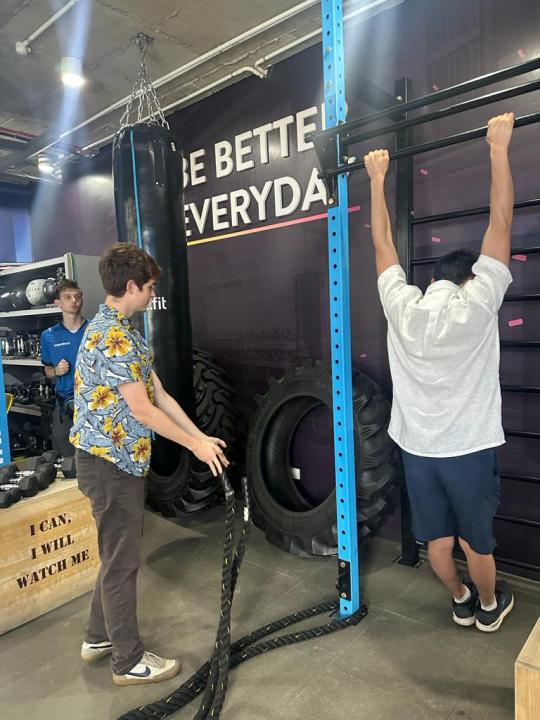
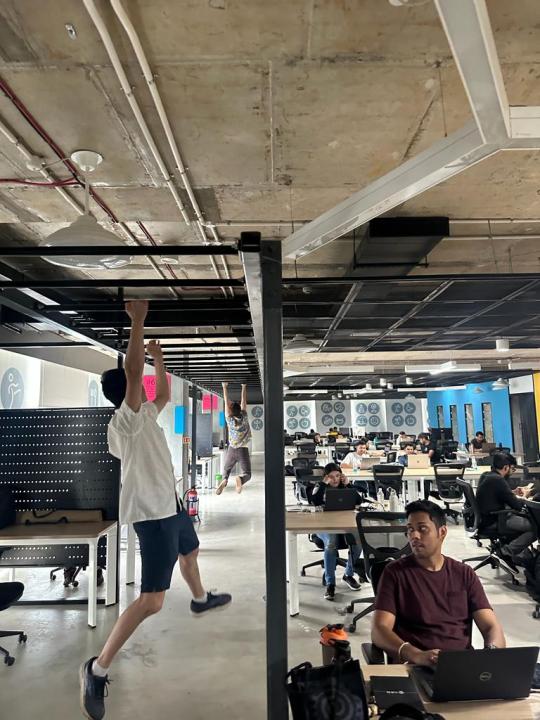


Then, we listened to a presentation from Shalabh, a strategy leader at CureFit. He gave us an overview on CureFit, and told us that they are a new age company attempting to make health easy in India. After that, Mujtabha, who works in the fitness group, spoke to us about the fitness business within CureFit, CultFit. He told us that CultFit exists in 90 cities across India. Then Shahbaaz, a brand manager, presented to us and told us about an exciting upcoming collaboration with Marvel. Next, we had lunch on the open-air top floor. We ate the delicious and nutritious Indian food that CureFit caters for its workers every day.
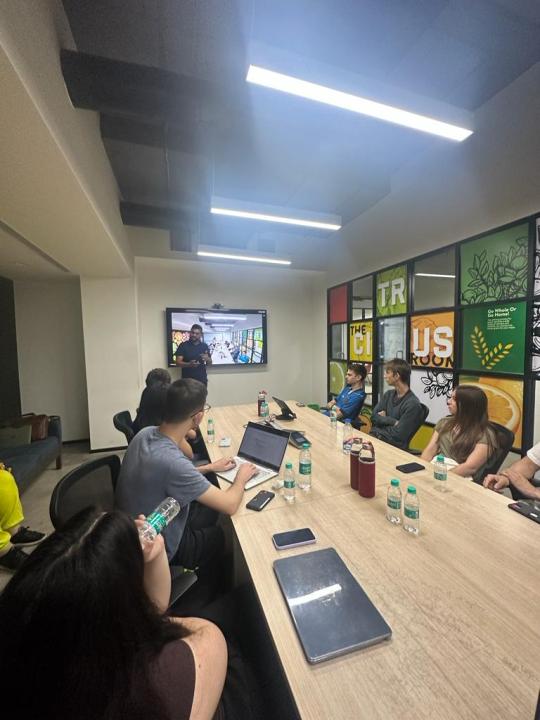



After lunch, we listened to Phalguni present on the brand and marketing side of CureFit. She taught us that CureFit has the mission of making fitness fun, easy, and accessible. Then Rishi presented to us and showed us CureFit advertisements. Lastly, Mujtabha told us about the history of the company, and his journey working at CureFit. It was a pleasure getting to learn from so many inspiring members of the CureFit team. Then, we celebrated Gauravi’s birthday with a chocolate cake. Pictured is Sagar feeding the cake to her after we sang. Finally, we visited SugarFit, a health-tech company owned by CureFit that aims to manage and reverse diabetes.

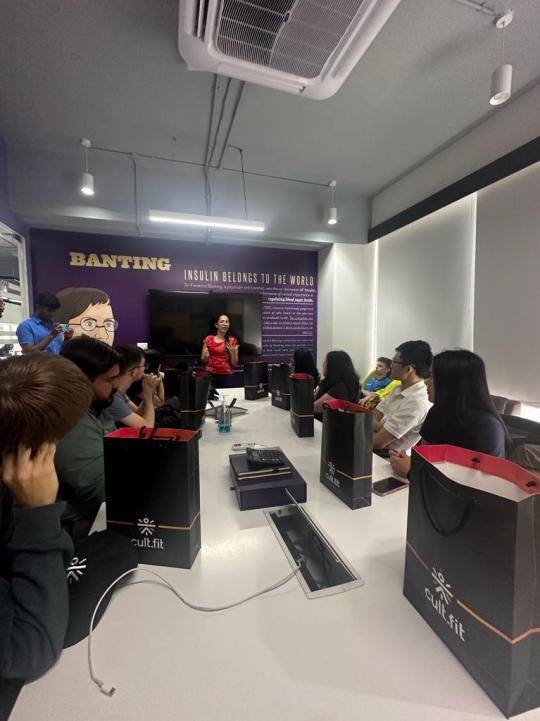



To end our visit, we did a CultFit Zumba class. It was easily one of the highlights of my time in India. It was a great break from our learning and work! We came back to the hotel and all did our own thing for dinner because we are prioritizing our case studies due this week. Excited to visit the Incubation Cell tomorrow!

2 notes
·
View notes
Text
Kuala Lumpur: Estuary of Cloudy Streams
”The world was so recent that many things lacked names, and in order to indicate them it was necessary to point.”
This may be the most fitting description of what I encountered as trying to order the breakfast in the Little India, Kuala Lumpur. Sitting outside the door, a customer was having a balloon-resembled food, something between bread and pancakes. I wanted to order the same thing but didn’t know how to express it, so I simply pointed to the photo on the menu and ordered what looked the most similar to it.
”We don’t have that anymore,” the waiter spoke with a southern accent, ”because…blah blah blah. Would you like something else?” I could understand nothing more than 70% of what he said, and ended up ordering something else that looked somewhat similar. What came was a round and crispy, deep-fried balloon-like pancake, like a inflated Chinese scallion, served with coconut milk and curry. The curry was mild, scattered with powdery-textured potatoes. the ‘pancake’ tasted pretty good with it. I ordered a glass of Lassi, whose sweetness is so strong, that I canconsider it as a standard accompaniment to Indian cuisine for me.
What was the name of that dish again?
I wandered through Little India looking for a place to buy souvenirs. The supermarket shelves were stocked with coffee, jam, oil products, various canned soups, and incense for prayer. There were several buckets filled with a variety of spices in the center of the supermarkets. The bag of branded coffee and the Kaya jam, which my friend highly-recommended, was eventually found at a department store on the upper level of Central station, or in Malay, Stesen Sentral.
After buying a ruby chocolate, which was said cannot be found in Taiwan, at the chocolate exhibition hall, I called a Grab ride to go to a western-style coffee shop in Chinatown on Jalan Petaling. I ordered a ”Summer Time”, a mix of lychee and watermelon juice, and began to write about my experiences in Kuala Lumpur. It suddenly came to my mind: the Indian dish I had for my breakfast, made of curry, coconut milk, and crispy bread.
We still don’t know the name of the dish we had that day.
The recitation of the Quran resonates during Zuhr.
The streets of Kuala Lumpur have a distinct tropical humidity, yet with a touch of freshness, which perhaps derived from the Muslims’ cleanliness, preventing the unpleasant odor of damp and muddy drains. Kuala Lumpur, Estuary of Cloudy Streams, at the confluence of muddy swirling currents; Muslims established mosques at the convergence of the Gombak River and the Klang River, and later the British built various Mughal-Gothic-styled government buildings in the same area.
As Crows gather along the riverbank and search for twigs to build their nests, a group of hijab-wearing college students happily pose for pictures with the architecture. An afternoon thunderstorm suddenly washes away the restlessness in the hearts of the diverse tourists. They quietly hide themselves under the covered walkways, listening to the recitation of the Quran emanating from the Masjid.
Time seems to been fragmented, yet never ceases to flow.
According to the Malaysian history book, the official version of Malaysia’s founding epic told us Malays came from Sumatra. ”A prince who lost his kingdom take his people to come to this land for rebuilding what they once had,” and they rooted themselves here, never to return to the other side of the straits. In the market, the aroma of coffee were permeating the air, and carried far away by the tropical breeze. A Tamil vendor introduced me to beautiful batik shawls. In my not-so-fluent English, I negotiated the price with him and ended up buying ones I’m pretty sure I would love.
Gentle sunlights spilling onto the shading canvas, notes of diaspora danced, in the fluttering signs of the bazaar, amidst the bustling city traffic, and within the oscillating fans at the train station. Secret-society members drifted here from the Northern Empire, Sri Lankan merchants brought by the monsoon winds, and the eventually settled-down Indonesian royal members, they are all smoothly shaped by the river flow into the time, slowly extending into an unending melody within stories.
The recitation of the Quran resonates during Asr.
In the cafeteria of the old Kuala Lumpur station, Ayam Tandori filled the air with a fragrant aroma. Although the beauty of the old station building couldn’t be captured by a camera, it appeared particularly lovely in the sunset. A photography team was taking pictures of a couple in front of the train station, though I couldn’t quite tell if they were shooting wedding photos or being Cosplayer.
The river, quietly flowed through the city, the Railwat went towards the harbour of Port Klang, and they would never to return. I watched the bustling traffic in front of the station, that forming an ever-turning roundabout, which are so fast, that seems in the next second, they would all dissolve into cream as the way tigers melt away.
Time clearly never ceases to flow, yet it is fragmented in a montage-like manner.
I delved into the crevices of history, let the approaching time drenched my body; Like a camel traversing the endless Silk Road, looking back at the scriptures I once wandered through. Inside the Islamic Arts Museum, I gaze at the coins displayed in glass cabinets, forming a long timeline connecting the end of the Silk Road to another end: the Umayyads, the Abbasids, the Fatimids; the Ayyubids of the Kurds, the Safavids of the Persians, the Mughals of the Mongols… Distant faith and the sound of prayers gradually reach the scattered archipelago of islands.
The guide at Masjid Negara introduces me to the distinctive features of their religious architecture: geometric patterns, designs devoid of images, and Arabic calligraphy that adorns every corner. He mentions that the average Malays do not truly understand Arabic, just like the Chinese, who do not really understand ”Namo Amitābhāya” or ”Om Mani Padme Hum.” However, the devoutness during prayer may overcome the language barrier, allowing the heartfelt yearning for tranquility to be conveyed genuinely to the beloved deity.
The peaceful coolness from the floor of Masjid gently touches my skin through my socks.
The recitation of the Quran resonates during Maghrib.
Perhaps due to its tropical location, even on weekends, one can feel that the nights and days in Kuala Lumpur are like different worlds. The deserted Independence Square during daytime comes to life at night with several food trucks gathering there. People ride bicycles and blow bubbles in front of the old government building, while the shimmering neon lights make the city’s stories vibrant.
At the night market on Petaling Street, the tables and chairs are already packed tightly by the vendors, making it difficult for the traffic to move. The aroma of delicious jerky fills the air, with each bite, I can feel its fresh, sweet, and crispy taste. I picked a few satay skewers, fried snacks, and even buy a serving of Balinese-style char siu rice. Slowly, I move to Bukit Bintang, the Starhill Avenue, where you can see a group street performers sing loudly in front of the subway station. The audience gathers in a circle on the sidewalk, eager to listen to their voices. Coinciding with the floral procession of Vesak Day, the streets are under traffic control, and Buddhist followers from around the world ride float after float, showering blessings upon those around them.
I step into a karaoke bar. It’s sparsely populated. I order a cola and sit at the counter. A staff member accosts me in a simple conversation in English. She tells me she is a Chinese from Myanmar, with a younger brother studying Mandarin in Taiwan, and a sister already married and has children in Taiwan. She proudly shows me photos of her siblings. The bar owner is Hakka, and I casually recite a few phrases in Hakka that I heard in the Subway announcements from Taiwan: ”Sṳ̀n-mùng-ǹg, án-chṳ́-se.” However, she looks puzzled. I ask her how to say ”thank you” in Malaysian Hakka, and she replies with ”唔該,” with the Hakka pronunciation. Haha, we bridge the language barrier and make ourselves understood. I select a song by Sandy Lam and another one by Jay Chou on the jukebox, At Least I’ve Got You, even if I Find It Hard To Say. A Japanese customer orders a beer, and as it pours into the glass, it turns into Bubble, as G.E.M. sings. The bar owner suddenly suggests that we should go together to taste some street food at Jalan Alor after closing. In the stir-fry restaurant, we order five servings of chicken wings, a large plate of fried noodles, and the Malaysians’ favorite ”lala” (clams). I thought it was a phonetic mistake for ”lâ-á” in Hokkien, but as I eat, the clams in front of me seem to play the ”Lala Land.”
I recall the previous night when I sneaked into a bookstore and browsed through interesting English books, searching for fragments of stories that have died but not yet been buried, as if I were a wandering ghost. That’s it. Knowing that stories don’t end like this, that’s it. Knowing that time doesn’t put a full stop on us, that’s it. Knowing that those timelines hidden in the Islamic Museum, the clocks that calculate prayers in the Masjid Negara, and the novels in my backpack are not the end of history. That’s it, I think.
I love Kuala Lumpur’s converging all of the stories, yet it hasn’t written the final chapter.
The recitation of the Quran echoes during Isha.
On the plane, I turned on my e-book reader and continue reading the unfinished book about Malaysian history: Portuguese captured Malacca, the White Rajahs ”inherited” Sarawak, the British and Dutch partitioned the Malay world, and the colonizers attempted to build a better world, like Raffles and Swettenham. The plane takes off towards the north, and outside the window, the weather is clear, with clouds leaping alongside the aircraft.
Once again, I hear the recitation of the Quran, reminding me of Fajr.
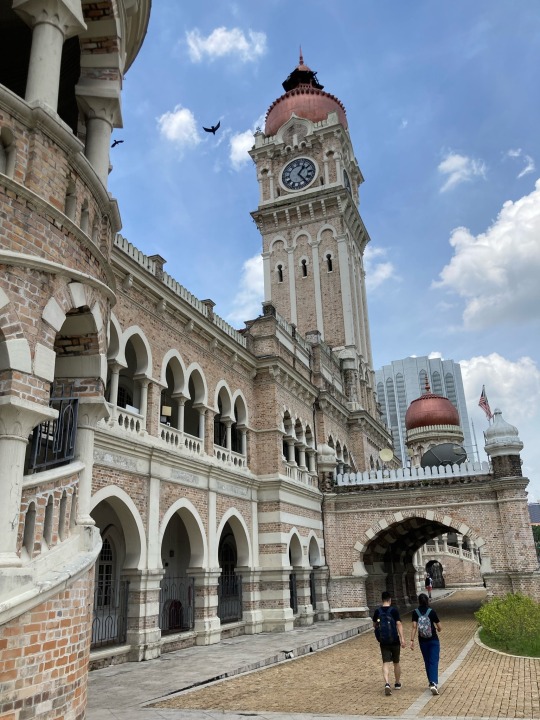






3 notes
·
View notes
Text
Top trusted stock market advisors in India
If you are looking for the best and the top trusted stock market advisors, you need to be careful as many advisors in India claim more than what they can deliver. You will have to put in some effort to find the best stock market advisor in India. To get you started, here are two most vital things to look for:
SEBI registered advisors: The Securities and Exchange Board of India (SEBI) is the regulatory body for the Indian stock market. Only SEBI-registered advisors are authorized to provide investment advice. You can verify an advisor's registration on the SEBI website https://www.sebi.gov.in/.
Investment advisors with a track record: Look for advisors with a proven history of success. It does not guarantee future results, but it can be a good indicator of their expertise. Also, don't go by what is mentioned on their website or what they say - look for references and get the exact numbers.
Important Points
You will have to put in the effort to create your list, the above two points should help. In addition to them, take care of the below points as well:
Beware of unrealistic promises: If an advisor guarantees high returns with low risk, it is probably a scam.
Ask about fees: Be clear about the fees associated with the advisor's services.
Don't invest in anything you don't understand: Ensure you understand the risks involved before investing in any stock or security.
If you are unable to finalize a human final advisor - you can always consider an AI-driven stock advisor to help you create your equity portfolio. AI-based advisors are more affordable and can monitor your portfolio 24*7.
#jarvisinvest#aibasedadvisor#best stock market advisor in india#top stock advisors in india#ai financial advisor#best stock advisor in india#stock advisory company
0 notes
Text
Best Hotel in Bhopal
Bhopal, the capital city of Madhya Pradesh, is a remarkable blend of history, culture, and modernity. Known as the "City of Lakes" due to its numerous natural and artificial lakes, Bhopal is a city that attracts tourists from all over the world. Amidst its rich heritage and picturesque landscapes, finding the perfect place to stay can be challenging. If you're looking for the Best Hotel in Bhopal that offers a harmonious blend of comfort, luxury, and impeccable service, look no further than the Lemon Tree Hotel, Bhopal.
Prime Location
Situated in the vibrant heart of Bhopal, the Lemon Tree Hotel enjoys a strategic location that offers easy access to both business and leisure destinations. The hotel is conveniently located near the Habibganj Railway Station, making it an ideal choice for travellers arriving by train. Moreover, its proximity to major attractions like the Upper Lake, Van Vihar National Park, and the bustling New Market ensures that guests can explore the city's highlights with ease.
Elegant Accommodations
The Lemon Tree Hotel, Bhopal, boasts an array of elegantly designed rooms and suites that cater to the needs of both business and leisure travelers. The hotel offers a variety of room categories, including superior rooms, executive rooms, and suites, each thoughtfully designed to provide a comfortable and luxurious stay.
The rooms are tastefully furnished with modern amenities such as high-speed Wi-Fi, flat-screen TVs, well-stocked minibars, and plush bedding to ensure a restful night's sleep. The attention to detail in the room decor, with warm tones and contemporary design elements, creates a welcoming and relaxing ambiance.
Dining Excellence
One of the standout features of the Lemon Tree Hotel, Bhopal, is its exceptional dining options. The hotel houses several in-house dining venues that cater to diverse culinary preferences. Citrus Café, the all-day dining restaurant, offers a vibrant and cheerful atmosphere, perfect for enjoying a hearty breakfast, a leisurely lunch, or a sumptuous dinner. The menu features a delightful mix of Indian, Asian, and Continental cuisines, prepared by skilled chefs using fresh and locally sourced ingredients.

State-of-the-Art Facilities
Lemon Tree Hotel, Bhopal, goes above and beyond to ensure that guests have access to top-notch facilities and services. The hotel features a well-equipped fitness centre, allowing guests to maintain their workout routines while travelling.
Business travellers will appreciate the hotel’s comprehensive business services and facilities. The hotel has multiple conference and meeting rooms equipped with the latest audio-visual technology, making it an ideal venue for corporate events, seminars, and meetings. The hotel’s professional event planning team is always on hand to assist with organising and executing successful events.
Exceptional Service
What truly sets the Lemon Tree Hotel, Bhopal, apart is its commitment to providing exceptional service. The hotel staff are known for their warm hospitality and attentiveness, ensuring that every guest's needs are met with efficiency and a smile. From the moment you step into the hotel, you are greeted with a refreshing welcome drink and escorted to your room, where a seamless check-in process awaits.
The concierge service at Lemon Tree Hotel is always ready to assist with travel arrangements, sightseeing tours, and any special requests. Whether you need a recommendation for a local restaurant, help with booking tickets to a cultural event, or advice on exploring the best of Bhopal, the knowledgeable and friendly staff are eager to help.
Commitment to Sustainability
Lemon Tree Hotels are known for their commitment to sustainability and social responsibility, and the Bhopal property is no exception. The hotel implements various eco-friendly practices, such as energy-efficient lighting, water conservation measures, and waste management programmes, to minimise its environmental footprint. Additionally, Lemon Tree Hotels are renowned for their inclusive hiring practices, providing employment opportunities to differently-abled individuals, and contributing positively to the community.
Conclusion
When it comes to finding the best hotel in Bhopal, the Lemon Tree Hotel stands out as an exceptional choice. Its prime location, elegant accommodations, superb dining options, state-of-the-art facilities, and outstanding service make it the perfect destination for both business and leisure travellers. Whether you are visiting Bhopal for a short stay or an extended trip, the Lemon Tree Hotel promises a memorable and delightful experience, ensuring that you leave with fond memories of your time in this enchanting city.
0 notes
Text
Best Residential and Commercial Properties For Singapore NRIs in India

1 Why Investment4NRIs is an Optimum Choice for Investment
India’s Leading NRI Realty Channel:
Investment4NRIs is a premier channel catering to non-resident Indians (NRIs) looking to invest in the best residential and commercial properties for Singapore NRIs in India. With years of expertise and deep market understanding, we connect NRIs with the most lucrative investment opportunities in India's booming real estate market.
INR 1500 Crores Worth Stock Sold In Last 5 Months:
Showcasing our robust performance, Investment4NRIs has successfully facilitated transactions worth INR 1500 crores in just the last five months, highlighting our efficiency and the trust investors place in us.
Serving NRIs All Over The Globe:
Our global outreach ensures that NRIs worldwide can access top-notch investment options, regardless of location.
Nri 24x7 Assistance
Understanding the unique challenges NRIs face when investing in India, we provide round-the-clock assistance to guide our clients through every step of the investment process.
Events In Your City
We regularly host informative events in various cities around the world to educate and connect with our NRI clients, providing them with up-to-date information and tailored advice.
DLF & Birla Group No.1 NRI Channel
Our exclusive partnerships with leading developers like DLF and Birla Group ensure our clients access the most prestigious and sought-after properties in India.
2 Trending Residential Projects in India for Investment
Adani Samsara Gurgaon: Adani Samsara offers luxurious villas and townhouses in a serene environment, making it a perfect blend of comfort and style in the real estate market.
Birla Navya Gurgaon: Birla Navya is a lifestyle estate with thoughtfully designed homes that promote sustainable living while offering modern amenities.
DLF Sector 77 Gurgaon: This project presents a chance to own exquisite residences in a prime location, promising both luxury and a great return on investment.
Trump Tower in Gurgaon: Trump Tower symbolizes prestige and luxury, offering meticulously designed apartments with panoramic skyline views.
DLF Camellias - Gurgaon: DLF Camellias provides ultra-premium apartments for those who desire grandeur and exclusivity in their living spaces.
3 Trending Commercial Projects in India for Investment
Lodha Trump Tower: Located in Mumbai, this iconic tower offers state-of-the-art commercial spaces ideal for businesses looking to elevate their brand presence.
Lodha Park: Lodha Park in Mumbai blends luxury offices and retail spaces within a bustling commercial hub that attracts significant footfall.
Lodha Adrina: Another gem in Mumbai, offering premium office spaces that cater to the high demands of modern businesses.
Birla Niyaara Worli: Birla Niyaara stands out for its innovative design and strategic location, making it a coveted address for corporate giants.
4 Procedures for Singapore NRIs to Invest in Property in India
Investing in India is streamlined for Singapore NRIs through our comprehensive services that guide them through the regulatory environment, ensuring a smooth transaction process from start to finish.
5 Document Differences and Eligibility for NRI Home Loans
Essential Documents for NRI Home Loans:
Passport and Visa: To verify identity and NRI status.
Employment Contract/Appointment Letter: To confirm employment details.
Labor Card/ID: Necessary for NRIs in the Middle East, requiring specific attestations.
Salary Certificate and Bank Statements: To ascertain financial stability and earnings.
Passport Copy with Visa Stamp: Critical for validating overseas residential status.
Business Profile and Trade License: For self-employed NRIs, proving business legitimacy.
Bank Statements from Overseas and NRE/NRO Accounts: To trace financial history and fund sources.
0 notes
Text
From Groceries to Gadgets: India’s Best Shopping Apps for Every Need
In the digital age, shopping has been transformed by mobile apps, making it easier than ever to buy everything from groceries to gadgets with just a few taps on your smartphone. India, with its rapidly growing e-commerce market, offers a plethora of shopping apps catering to various needs. Whether you’re looking for fresh produce, the latest electronics, or fashion trends, there’s an app for you. Here’s a guide to some of India’s best shopping apps for every need.
1. BigBasket: The Ultimate Grocery App
When it comes to grocery shopping, BigBasket stands out as the most reliable app in India. Offering a wide range of products including fresh fruits, vegetables, dairy, and household essentials, BigBasket ensures that your kitchen is always well-stocked. The app’s user-friendly interface, combined with features like scheduled delivery and multiple payment options, makes grocery shopping convenient and hassle-free. BigBasket also offers attractive discounts and loyalty points, making it a favorite among Indian households.
2. Amazon India: Your One-Stop Shop for Everything
Amazon India needs no introduction. As the leading e-commerce platform in the country, Amazon offers an extensive range of products across all categories – from electronics and clothing to groceries and home essentials. With features like Prime membership, which offers benefits like free delivery, early access to deals, and exclusive content, Amazon ensures a seamless shopping experience. The app’s robust search functionality, personalized recommendations, and reliable customer service make it a go-to for millions of shoppers.
3. Flipkart: The Best for Electronics and Gadgets
Flipkart is another giant in the Indian e-commerce space, known particularly for its electronics and gadgets. From smartphones and laptops to home appliances and gaming consoles, Flipkart offers competitive prices and exclusive deals on a wide range of tech products. The app’s easy-to-navigate interface, comprehensive product descriptions, and user reviews help you make informed decisions. Additionally, Flipkart’s Big Billion Days sale is a highly anticipated event, offering massive discounts across various categories.
4. Myntra: Fashion at Your Fingertips
For fashion enthusiasts, Myntra is the ultimate destination. Offering an extensive collection of clothing, footwear, and accessories from top brands, Myntra caters to all fashion needs. The app is known for its trendy collections, curated looks, and personalized recommendations. Myntra’s user-friendly interface, combined with features like easy returns, size guides, and style tips, makes online fashion shopping a delightful experience. The app also frequently offers sales and discounts, ensuring you always get the best deals on your favorite brands.
5. Nykaa: Beauty and Wellness Haven
Nykaa has revolutionized the beauty and wellness shopping experience in India. The app offers a vast range of beauty products, including makeup, skincare, haircare, and fragrances from both international and local brands. Nykaa’s detailed product descriptions, customer reviews, and expert recommendations help you choose the right products for your needs. The app also features beauty tutorials and tips, making it a comprehensive platform for all things beauty. Nykaa’s frequent sales and exclusive launches make it a must-have app for beauty enthusiasts.
6. Grofers: Affordable Grocery Shopping
Grofers is another popular grocery shopping app that focuses on affordability and convenience. Offering a wide range of groceries, household items, and personal care products, Grofers ensures that you get quality products at the best prices. The app’s smart basket feature, which suggests products based on your purchase history, makes shopping quick and easy. Grofers’ regular discounts, cashback offers, and subscription plans like Smart Bachat Club provide additional savings, making it a favorite for budget-conscious shoppers.
7. Ajio: Trendy and Affordable Fashion
Ajio, a fashion and lifestyle brand from Reliance Retail, offers a unique collection of trendy and affordable clothing and accessories. The app features a curated selection of styles, exclusive Ajio labels, and products from popular brands. Ajio’s user-friendly interface, detailed product descriptions, and easy returns make it a great platform for fashion shopping. The app also offers regular sales and discounts, ensuring you get stylish products without breaking the bank.
8. Tata CLiQ: Quality and Trust
Tata CLiQ combines the trust and quality associated with the Tata brand with the convenience of online shopping. Offering a wide range of products across categories like fashion, electronics, and home essentials, Tata CLiQ ensures a premium shopping experience. The app’s CLiQ and PIQ feature allows you to order online and pick up your purchases from a nearby store, combining the best of online and offline shopping. Tata CLiQ’s reliable delivery, easy returns, and excellent customer service make it a trusted choice for shoppers.
9. Paytm Mall: Shopping and Payments Combined
Paytm Mall, an offshoot of the popular Paytm app, offers a comprehensive shopping experience combined with seamless payment solutions. The app features a wide range of products across various categories, competitive prices, and frequent discounts. Paytm Mall’s integration with Paytm Wallet allows for quick and easy payments, along with cashback offers and reward points. This combination of shopping and payments makes Paytm Mall a convenient choice for many shoppers.
10. Snapdeal: Value for Money
Snapdeal focuses on providing value for money, offering a wide range of products at affordable prices. The app features deals and discounts across categories like electronics, fashion, home essentials, and more. Snapdeal’s daily deals, flash sales, and seasonal promotions ensure that you always get the best prices. The app’s user-friendly interface and reliable delivery make it a popular choice for budget-conscious shoppers.
Conclusion
From groceries to gadgets, India’s shopping apps cater to every need, offering convenience, variety, and great deals. Whether you’re stocking up on household essentials, upgrading your tech, or refreshing your wardrobe, these apps provide a seamless shopping experience. By leveraging these top shopping apps, you can enjoy the best of online shopping, tailored to your specific needs and preferences. Download these apps today and transform your shopping experience in the digital age!
0 notes
Text
Key Factors Behind Radhakishan Damani’s Investment Decisions
Introduction
Damani is a name with a sagacity of the Indian stock market. His investment decisions and strategies are not just successful but serve as a blueprint for aspiring investors.
He founded Dmart, a major retail corporation, and became renowned as a seasoned investor in the Indian equity market. His portfolio has been studied and envied by many. To read more about Radhakishan Daman's portfolio and net worth, read our blog on Altius Investech.
The blog would highlight his strategic moves contributing to the notable success while offering valuable insights to investors.

Long-term investment mindset
With his long-term investment horizon, unlike traders focusing on short-term gains, Damani has invested in various companies for numerous years.
The philosophy and approach of purchasing and holding onto stocks from fundamentally strong companies lets him earn benefits from steady growth, dividend payouts, and appreciation of long-term capital.
Avenue Supermarts, the parent company of DMart, highlights a great example demonstrating the exponential growth attained from long-term holdings.
Damani has also invested in Chennai Super Kings – an IPL franchise backed by India Cements Limited. With an illustrious history, they have participated in a record 10 finals, won a record five IPL titles in 2010, 2011, 2018, 2021, and 2023, and qualified for the playoffs 12 times out of the 14 seasons they have played in, which is more than any other franchise.
To have your hands-on gains that we can vouch for, buy csk unlisted shares from Altius Investech starting from just ₹ 153.
Value in Investments
Damani looks out for companies that are undervalued as per their actual worth. Buying the stocks at prices lower than their real, intrinsic value, makes him position himself for considerable gains once the market corrects the undervaluation. The method needs a deeper understanding of the fundamentals of business, involving debt levels, competitive advantages, and revenue streams.
No to High-debt companies
A significant factor in his investment strategies is an aversion to organizations with high debt levels. Instead, he seeks companies with stronger cash flows and manageable debt. The conservativeness shields his investments from risks linked with high leverage, especially during economic downturns, causing stable returns.
Market Timing
What needs to be acknowledged is the way Damani times his entry or exit from businesses, impeccably. He willingly buys stocks when the market shows pessimistic values and sells as per his interest. For example, his entry into some specific apparel or cement stocks during the time of market lows let him reap considerable gains with the recovery of these sectors.
Market Cycles
Damani’s interpretation and understanding of the market cycles significantly contribute to his success. Through effective studies levied on investor behavior and market patterns, he can anticipate market dynamic shifts. The capability of reading the market makes him adjust his strategies as per the prevailing economic scenario.
Business Fundamentals
The decisions he makes in his processes analyze business procedures to invest only in companies having strong management, sustainable advantages, and clear strategies for growth. Instead of market speculation, he identifies companies offering potential and stability, irrespective of conditions of market volatility.
Diversification
With important holdings in the investments and retail sectors, Damani’s portfolio remains diverse across different industries. Diversification helps in the mitigation of risks as poor performance of one stock or sector is compensated by the gains or stability of the rest. This counts as a classic strategy that served him well over the decades.
Network and Mentorship
A close-knit group consisting of seasoned investors as friends and mentors, including the famous Rakesh Jhunjhunwala, gives him a network providing him with robust exchanges of strategies and ideas, and refining his investment tactics and decisions.
Conclusion
Several disciplined approaches happen to focus on value investing, fundamental analyses, and cautious approaches for debt as well as market timing, making a huge figure to emulate in the world of investment.
Investors who intend to mirror his success must understand and implement these principles as a step forward in earning significant returns in the volatile world of trading stocks. To further diversify and grow your investment, consider investing in unlisted shares on Altius Investech, a platform known for its promising opportunities.
0 notes
Text
A Turning Point in India's Economic Landscape: How the Financial Markets Reacted to the 2014 Lok Sabha Election Results
The 2014 Lok Sabha elections in India marked a watershed moment in the country’s political and economic history.
For the first time in 30 years, a single party, the Bharatiya Janata Party (BJP), secured a clear majority in the Indian Parliament, paving the way for Narendra Modi to become the Prime Minister.
This political shift had profound implications for the Indian financial markets,…

View On WordPress
#2014 Lok Sabha elections#Banking sector India 2014#BankingSector#BJP victory 2014#BJPGovernment#Economic reforms India#EconomicReforms#Election results market reaction#ElectionImpact#FinancialMarkets#Foreign direct investment India#ForeignInvestment#GST#GST Bill India#Indian financial markets#Indian stock market history#IndianEconomy#Infrastructure stocks India#InfrastructureStocks#Investor sentiment 2014#InvestorSentiment#Jan Dhan Yojana#JanDhanYojana#LokSabhaElections2014#Make in India#MakeInIndia#Market reaction to elections#MarketVolatility#Modi economic policies#Modi government policies
0 notes
Text
Dividend stock: Multibagger chemical stock declares final dividend for fourth straight year

Fineotex Chemical, a leading player in the chemical industry, is one of the dividend-paying stocks of the Indian stock market. The dividend stock has declared a 20 percent final dividend for its eligible shareholders, payable in the financial year 2023-24. After declaring this final dividend for FY24, the multibagger stock has gone on to announce a final dividend for the fourth year in a row. The chemical company declared a final dividend in FY21, FY22, and FY23 as well. The company announced the final dividend while announcing its Q4 results in 2024 on Wednesday evening.
Fineotex Chemical dividend details
The multibagger chemical stock informed the Indian stock market exchanges about the decision, saying, "In compliance with Regulation 30 of the SEBI (Listing Obligations and Disclosure Requirements) Regulations, 2015, it is informed that the Board has recommended a final dividend of Rs. 0.40/- per equity share (20% of face value of Rs. 2/- each) which amounts to Rs. 4,46,93,995.60/- (Rupees Four Crore Forty-Six Lacs Ninety Three Thousand Nine Hundred and Ninety Five Sixty Paise only) subject to the approval of members at the ensuing Annual General Meeting."
Fineotex Chemical's dividend history
As per the information on the official website of BSE, this is the fourth straight year when the dividend stock has declared its final dividend. The multibagger stock traded 'ex-dividend ', a term used to indicate that the buyer of the stock on or after this date is not entitled to the recently declared dividend, on 8 July 2021 for finalizing the list of eligible shareholders for payment of ₹0.30 per share final dividend. On 28 July 2022, the dividend stock traded ex-dividend for payment of ₹0.40 per share final dividend to the eligible shareholders. Last year, on 8 September 2023, Fineotex Chemical shares traded ex-dividend to ascertain eligible shareholders for payment of ₹0.80 per share final dividend.
In 2024, the dividend-paying stock traded ex-dividend on 26 February to ascertain the list of eligible shareholders for payment of ₹1.20 per share as an interim dividend.
Fineotex Chemical Q4 results
Fineotex Chemical's Q4 results have shown a promising increase in revenue. Revenue from Operations for the quarter rose to ₹153.01 crore from nearly ₹137.69 crore, marking an impressive growth of 11.13 percent. This positive financial performance is a testament to the company's strong position in the market and its ability to deliver consistent returns to its shareholders.
The Profit after tax (PAT) for the quarter ended has increased to around ₹30.48 crore from around ₹26 crore, i.e., a growth of 17.21 percent.
Multibagger stock
Fineotexh Chemical's share price rose from around ₹15 to ₹365 per share in the post-COVID period, a period marked by the company's resilience and adaptability to the changing market conditions. In these nearly four years, the chemical stock has delivered a whopping 850 percent return to its positional shareholders, a testament to our strong fundamentals and the trust of our investors.
0 notes
Text
Motilal Oswal: Leading the Way in Jaipur’s Best Stock Market

Introduction
Jaipur has gained acclaim for its long history, stunning architecture, vibrant social scene, and rising prominence in the financial sector. Jaipur has established itself as a significant player in the Indian stock markets during the last few years. Anyone considered investing in The Stock Marketshould study the present financial situation in Jaipur.
Jaipur's Progression to Financial Hub The present state
Jaipur's route to becoming a financial city provides proof of its robust financial growth and strategic improvement... The region's improved infrastructure, launching literacy rates, and business-friendly the setting are all key to the banking sector's steady growth.
Significant Players in the Stock Market of Jaipur
These companies are well known for focusing on the requirements of their clients, using modern technologies to produce perfect trading experiences..
Jaipur Stock Exchange
The Jaipur Stock Exchange (JSE) is important in history, though is not as significant as the Bombay Stock Exchange (BSE) or the National Stock Exchange (NSE). After its founding in 1989, JSE has been instrumental in forming the financial environment of the city. Considering the significant decline in its operations followed the arrival of electronic trading networks, it continue to be an important part of Jaipur's financial tradition.
Technology and Innovation
Technological has been employed by Jaipur's significant financial sectors in addition to its typical trade halls. The method in which citizens of Jaipur connect via the stock market has undergone major shifts as the result of the popularity of trading platforms online. Businesses like Motilal Oswal and Upstox are attracting attention by providing uncomplicated platform that let traders of any level of skill participate. Such systems help investors make better judgments by providing a wide range of selling tools, data in real time, and comprehensive researach on the market.
Opportunities for Making investments
The are thousands of potential investments in Jaipur to suit a wide range of investment tastes. The city's financial market is loaded with possibilities from widely recognized mutual funds and blue-chip enterprises to fresh firms and real estate investment trusts (REITs). Reflecting larger national and international trends, local investors showed an intense interest in industries like computing, medicines, and energy efficiency.
The Road Ahead
The most successful stock market in Jaipur continues to be headed for an optimistic future caused by continuing creativity and rising investor base. It is planned that as more homeowners have access to wealth and educational possibilities, the city's stock market will keep growing. This economic orientation sessions will also depend on reactions taken by government organizations to promote investment and innovation.
Jaipur brings investors through an uncommon blend of current trading strategies and regular investment processes.
Conclusion
The city's financial markets will flourish behind it, delivering a solid base for trading and potential economic expansion.
Whatever their abilities are, The Jaipur Stock Market environment offers an achieving and crucial experience. The city is an intriguing decision for anyone considering investing in India's expanding GDP because of its excellent blend of technical inventiveness and cultural standards.
#invest#stockmarket#best stock broker in india#best stock market advisor#best stock trading apps in india#best stock advisor in india#motilal oswal#investment#nseindia#finance news#broking firm in jaipur#stockmarket jaipur#best stock market in rajasthan#broking firm#us stock market#us state department#us stuff#us news#usa
0 notes
Text
Factor ETFs: A Strategic Approach for Long-Term Value Creation in the Indian Market
The Indian capital market presents a dynamic landscape for investors. Traditional index funds and ETFs based on market capitalization have long been the cornerstone for achieving diversified exposure. However, a new breed of exchange-traded vehicles is gaining significant traction: Factor ETFs. This article explores the concept of Factor ETFs, analyzing their potential to deliver long-term value creation for investors in the Indian context.
Demystifying Factor ETFs
Factor ETFs are a unique category of Exchange-Traded Funds (ETFs) that track specific investment strategies. Unlike their market-cap weighted counterparts, they focus on distinct characteristics (factors) of companies within an underlying index. These factors, such as value, quality, momentum, and low volatility, aim to capture specific market inefficiencies and potentially outperform the broader market over extended periods.
The Rise of Factor Investing in India
Historically, Indian investor preference leaned towards market-cap weighted index funds, where investments are allocated proportionally to a company's market size. However, factor investing offers a more nuanced approach. It allows investors to target specific company attributes believed to be drivers of superior returns. As the Indian capital market matures, Asset Management Companies (AMCs) are increasingly incorporating factor-based investment strategies into their offerings to cater to evolving investor preferences.
Key Factors Driving Performance in Factor ETFs
Let's delve into some prominent factors incorporated into Factor ETFs:
Value Investing
This strategy focuses on companies trading below their intrinsic value, identified through metrics like price-to-earnings (P/E) ratio or price-to-book (P/B) ratio. The underlying belief is that these undervalued stocks have the potential for future price appreciation as the market recognizes their true worth.
Quality Investing
This approach prioritizes companies with robust financial health, strong profitability, and sustainable competitive advantages. These companies tend to exhibit stability and resilience during market downturns, making them attractive for long-term investors seeking consistent returns.
Momentum Investing
This strategy targets stocks with a history of strong price appreciation, aiming to capitalise on the continuation of that upward trend. These stocks are often associated with positive company news, robust earnings growth, or industry tailwinds.
Low Volatility Investing
This approach focuses on companies with historically lower stock price fluctuations. These companies may offer steadier returns, making them suitable for risk-averse investors seeking to minimize portfolio volatility.
Benefits of Factor ETFs for Indian Investors
Factor ETFs offer several compelling advantages for Indian investors seeking long-term wealth creation:
Diversification Beyond Market Cap
Factor ETFs provide exposure to a basket of companies selected based on specific criteria, offering diversification beyond just market capitalisation. This can help mitigate risk and potentially enhance portfolio returns.
Targeted Exposure to Desired Characteristics
Investors can choose Factor ETFs that align with their investment goals and risk tolerance. For example, value-oriented investors can target value ETFs, while those seeking stability might opt for low-volatility ETFs.
Potential for Superior Long-Term Returns
Backed by historical data, factor investing strategies have shown the potential to outperform the broader market over extended periods. Value and momentum factors, in particular, have exhibited a tendency to deliver higher risk-adjusted returns.
Investing with Prudence
Understanding Fees: Factor ETFs typically have slightly higher expense ratios compared to traditional market-cap weighted ETFs. Evaluate the fees associated with a particular ETF before investing.
Active Management vs. Passive Management: Factor ETFs represent a passive investment strategy, but the underlying index selection process involves active management decisions. Understand the methodology behind the factor selection of the chosen ETF.
Long-Term Commitment: Factor investing strategies are best suited for a long-term investment horizon. Market fluctuations can impact short-term performance.
Seek Professional Guidance: Consider consulting a qualified financial advisor to determine if Factor ETFs align with your individual financial goals and risk tolerance.
The Future of Factor ETFs in India
The Indian ETF market is witnessing a continuous evolution, with Factor ETFs emerging as a significant growth segment.As the market matures and regulations evolve, we can expect a wider array of Factor ETFs catering to diverse investor needs. Factor investing offers a strategic approach to potentially outperform the broader market and achieve long-term wealth creation. However, thorough research, a prudent investment strategy, and a long-term perspective remain paramount for success in the dynamic Indian capital market.
0 notes
Text
Which Transaction Platforms Do Mutual Fund Software in India Have?

For mutual fund distributors (MFDs) in India, efficiency is paramount. Juggling client requests, managing investments, and navigating compliance can be a time-consuming task. This is where robust mutual fund software in India comes in – offering a one-stop shop to streamline your operations. But what about the actual buying and selling of mutual funds? Transaction platforms enter here.
These platforms act as the bridge between your software and the mutual fund houses, allowing you to seamlessly execute transactions on behalf of your clients. But with multiple players in the Indian market, choosing the right platform can feel overwhelming.
In this article, we'll explore the world of transaction platforms for mutual funds in India. We'll delve into the three major players – NSE NMF, BSE STAR MF, and MFU –, compare their functionalities, and highlight the key benefits of having them all consolidated within our fund management software.
What are Transaction Platforms
Think of a transaction platform as a secure online portal that connects your portfolio software directly to the databases of Asset Management Companies (AMCs). This eliminates the need for manual form filling and submission, saving you valuable time and minimizing errors.
Here's a breakdown of the key functionalities offered by transaction platforms:
Transaction Processing: Execute purchase, redemption, switch, and Systematic Investment Plans (SIP) for your clients.
Order Management: Track and monitor the status of your transactions in real-time.
Account Management: View client folios, holdings, and transaction history with ease.
Compliance Support: Generate transaction confirmations and other reports for regulatory requirements.
The Major Platforms in India
The Indian mutual fund industry boasts three primary transaction platforms – NSE NMF, BSE STAR MF, and MFU. Let's take a closer look at each:
NSE NMF (National Stock Exchange)
Strengths: Free distributor registration, almost all major fund houses present, APIs are provided to create white label front office for advisors, extensive reach.
Considerations: May require additional integrations with your software, a Deposit of Rs 15,000 for individual distributors and Rs 25,000 for corporate distributors, and an ordinary user interface.
BSE STAR MF (Bombay Stock Exchange)
Strengths: User-friendly interface and robust order management tools, Free Distributor Registration, One Time Unique Client Code (UCC) for investors. Thereafter complete online process. Instant investment possible.
Considerations: Might have slightly lower AMC coverage compared to NSE NMF, User interface is very ordinary.
MFU (Mutual Funds Utilities India)
Strengths: User interface is better than others, all major AMCs are present, One-time common account number (CAN) registration for investors, and free distributor registration
Considerations: May have limitations in functionalities compared to the other two options like live portfolio feeds and corporate transactions not allowed.
Choosing the Right Platform
The ideal transaction platform for your needs depends on several factors:
AMC Coverage: Ensure the platform provides access to the AMCs you and your clients frequently invest in.
User Interface: A user-friendly platform streamlines your workflow and minimizes errors.
Integration with your Software: Seamless integration ensures smooth data flow and avoids manual data entry.
Compliance Features: Robust features help you meet SEBI regulations with ease.
The Software Advantage: All Platforms, One Solution
Here's where our software shines. Our state-of-the-art mutual fund software in India integrates seamlessly with all three major transaction platforms – NSE NMF, BSE STAR MF, and MFU. This empowers you with:
Unmatched Flexibility: Choose the platform that best suits your specific needs and AMC preferences.
Streamlined Workflow: Execute transactions across all platforms from a single, unified interface.
Enhanced Efficiency: Eliminate the need to switch between different platforms, saving you valuable time.
Reduced Errors: Data flows seamlessly between your software and the platforms, minimizing manual intervention.
Compliance Made Easy: Generate reports and fulfill regulatory requirements effortlessly.
By consolidating all transaction platforms within the software, you gain a centralized hub for managing your entire mutual fund business.
Conclusion
Transaction platforms are a cornerstone of efficient mutual fund distribution. By understanding the functionalities of the major players in India and leveraging the comprehensive platform integrations offered by us, you can streamline your workflow, enhance client satisfaction, and focus on what matters most – growing your business.
Ready to unlock the power of unified transaction platforms?
Get in touch with us today and experience the future of mutual fund distribution. Visit our website at https://redvisiontechnologies.com/
#Mutual Fund Software#Mutual Fund Software For Distributors#Mutual Fund Software For IFA#mutual fund software in India#Mutual Fund Software For Distributors in India#Top Mutual Fund Software in India#Best Mutual Fund Software in India#Best Mutual Fund Software for Distributors in India#Top Mutual Fund Software for Distributors in India#Best Mutual Fund Software For IFA in India#Top Mutual Fund Software For IFA in India#Best online platform for mutual fund distributor#wealth management software in india#best wealth management platform#crm software for mutual fund distributor
0 notes
Text
FOSTIIMA Business School: A Comprehensive Overview

Introduction:
In the evolving landscape of global business education, FOSTIIMA Business School has emerged as a prominent institution known for its unique approach to management education. Founded by alumni of the prestigious Indian Institute of Management Ahmedabad (IIM-A), FOSTIIMA aims to provide world-class business education aligned with current industry requirements. This blog explores the history, programs, campus life, faculty, industry linkages, and overall impact of FOSTIIMA Business School to comprehensively understand what makes it an excellent choice for aspiring business professionals.
History and Vision:
Founded in 2007, FOSTIIMA Business School (FBS) was born with a vision to bring the legacy of excellence associated with IIM-A to a wider audience. The acronym FOSTIIMA stands for “Friends Of the Stars of IIM-A”, reflecting the founders’ commitment to nurturing future leaders by leveraging their vast experience and network. The school's mission is to bridge the gap between theoretical knowledge and practical business acumen, ensuring graduates are prepared to meet the challenges of the corporate world.
Academic Programs:
FOSTIIMA Business School offers a wide range of programs focusing on business education. The flagship program is the Graduate Diploma in Business Management (PGDM), which is recognized by AICTE and is equivalent to an MBA. This program is available in several specialties, including:
Marketing: Focuses on modern marketing strategies, consumer behavior, and digital marketing.
Finance: Covers financial management, investment analysis, and corporate finance.
Human Resource Management: Covers organizational behavior, human resource management, and labor law.
Operations: Focuses on supply chain management, logistics, and process optimization.
Curriculum and Pedagogy:
FOSTIIMA's curriculum is carefully designed to combine theoretical frameworks with real-world applications. Courses are updated regularly to reflect the latest industry trends and technological advances. Teaching methods combine lectures, case studies, simulations, and project work. This approach allows students to not only understand theoretical concepts but also learn how to apply them to real-life scenarios. FOSTIIMA pedagogy is characterized by its emphasis on experiential learning. The institution encourages students to participate in real-life projects, internships, and industrial visits, providing them with practical experience. This practical insight is further enhanced through workshops, guest lectures, and seminars by industry experts and alumni.
Faculty:
The faculty of FOSTIIMA Business School comprises of experienced academicians and industry experts, many of whom are alumni of IIM-A. Her extensive academic background and extensive industry experience bring a unique blend of knowledge and practical insight to the classroom. Faculty are not only educators but also mentors who guide students on their academic and professional journeys. By participating in research and consulting projects, she stays abreast of the latest developments in her respective fields, which benefits her students.
Campus Life:
FOSTIIMA Business School offers a vibrant and dynamic campus life that greatly contributes to the overall development of students. The campus is equipped with state-of-the-art facilities including modern classrooms, a well-equipped library, computer labs, and recreational areas. The learning environment is also enriched by a variety of student clubs and committees that organize events, competitions, and cultural activities.
Student Clubs and Committees:
Student Clubs and Committees play an important role in promoting a holistic learning environment at FOSTIIMA. Some of the most famous clubs include:
Marketing Club: Hosts marketing workshops, guest lectures, and case study competitions.
Finance Club: Conducts events on financial analysis, stock market simulation, and investment strategy.
HR Club: Focus on human resource management, organizational behavior, and HR practices through interactive sessions.
Operations Club: Focuses on supply chain management, process optimization, and logistics through practical projects and discussions.
These clubs not only provide a platform for students to explore their interests but also help build leadership and teamwork skills.
Industry Links and Internships:
FOSTIIMA Business School has strong links with the corporate world, as evidenced by its impressive placement record. The institution's strong industry connections enable guest lectures, workshops, internships, and graduate internships. FOSTIIMA's career department works diligently to ensure that students have ample opportunity to connect with potential employers and secure well-paying job openings.
Deployment Process:
The deployment process at FOSTIIMA is systematic and well-organized. It begins with an interview where the company introduces itself and explains the roles and responsibilities related to the job opening. The recruitment process then follows and usually includes an aptitude test, group discussion, and personal interview. The Career Center provides comprehensive support to students throughout this process, including resume writing, interview preparation, and career counseling.
Employment Statistics:
FOSTIIMA has an impressive employment record with a high percentage of students getting jobs in reputed organizations in various fields. The average salary package offered to graduates is competitive, with many students securing multiple job offers. Prominent recruiters include multinationals, large Indian companies, and startups across sectors such as finance, consulting, FMCG, IT, and e-commerce.
Alumni Network:
A strong alumni network is one of the key benefits of FOSTIIMA Business School. Our graduates, who are well-positioned in a variety of industries, play an important role in mentoring current students and facilitating industry contacts. Regular reunions, webinars, and networking events are held to foster a sense of community and continued engagement.
International Presence:
In today's globalized economy, an international perspective is invaluable. FOSTIIMA Business School recognizes this and offers students a variety of opportunities to gain international experience. The institution maintains connections with several prestigious international universities and business schools, allowing for student exchange programs and global internships. These opportunities allow students to experience different cultures, understand global business practices, and expand their professional networks.
Fostering Entrepreneurship:
FOSTIIMA Business School focuses on promoting entrepreneurship among its students. The institute offers special courses and workshops on entrepreneurship and innovation. Additionally, the Entrepreneurship Cell (E-Cell) provides a platform for aspiring entrepreneurs to improve their skills, create business plans, and present their ideas to potential investors. E-Cell regularly hosts events such as startup boot camps, pitch contests, and mentorship sessions with successful entrepreneurs. These initiatives aim to provide students with the knowledge, skills, and confidence to embark on their entrepreneurial journey.
Research and Innovation:
Research and innovation are an integral part of the academic ethos of FOSTIIMA Business School. The institution encourages faculty and students to engage in research activities that contribute to the body of knowledge in various management disciplines. Research results are disseminated through renowned journal publications, conferences, and seminars. FOSTIIMA also collaborates on research projects with industry partners to provide practical solutions to real-world business problems. This collaboration not only enhances the learning experience but also ensures that research is relevant and impactful.
Corporate Social Responsibility (CSR):
FOSTIIMA Business School is committed to promoting corporate social responsibility and ethical business practices. The institution believes in developing socially responsible leaders who can make a positive impact on society. To achieve this objective, FOSTIIMA incorporates its CSR into its curriculum and encourages students to participate in various philanthropic activities. 4,444 students are participating in projects related to education, healthcare, environmental sustainability, and rural development. These efforts will deepen our understanding of social issues and the importance of responsible leadership.
Technology Integration:
In the digital age, technological competency is essential for businessmen. FOSTIIMA Business School integrates technology into the teaching and learning process to familiarize students with the latest tools and platforms. The facility uses advanced software for data analysis, financial modeling, project management, and more. Additionally, FOSTIIMA provides online learning resources, virtual classrooms, and simulation tools to enhance your learning experience. This technology integration not only makes learning more engaging but also prepares students for a technology-driven business environment.
Accreditation and Rating:
FOSTIIMA Business School is accredited by the All India Council for Technical Education (AICTE) which attests to the quality and authenticity of its programs. The institution has also received various awards for its contributions to management education. This includes rankings and awards from renowned educational institutions and media organizations, further highlighting our commitment to excellence.
Conclusion:
FOFOSTIIMA Business School stands out as a premier management education institution with a unique combination of academic rigor, practical experience, and industry relevance. The strong foundation built by IIM-A alumni, along with a comprehensive curriculum, experienced faculty, and strong industry connections make it an ideal choice for aspiring business professionals. Our focus on holistic development, international presence, entrepreneurship, research, and social responsibility makes our graduates well-rounded individuals ready to face the challenges of the corporate world. That's guaranteed. For those looking for an innovative educational experience that will equip them with the skills and knowledge they need for their careers, FOSTIIMA Business School is a worthy choice.
0 notes